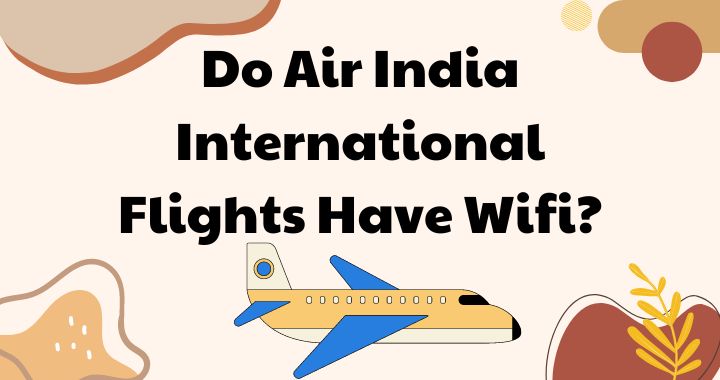In an age where constant connectivity is the norm, travellers have grown accustomed to staying connected, even at 30,000 feet. The demand for in-flight Wi-Fi on international flights has skyrocketed, leaving airlines like Air India grappling with the challenge of keeping up with passengers’ digital needs.
Do Air India International Flights Have Wifi?
Currently, Air India’s international flights do not offer in-flight Wi-Fi. According to the Times of India, the facility of Wi-Fi will be installed on all flights by 2025. Passengers often find themselves disconnected from the online world during their journeys. This limitation stands in stark contrast to the on-ground connectivity we’ve come to expect in our daily lives.
Hurdles in Providing In-Flight Wi-Fi Facilities
Here are some of the key hurdles airlines and the aviation industry face when providing in-flight Wi-Fi:
- Technical Challenges: The unique environment of an aircraft poses technical challenges for delivering consistent and reliable internet connectivity. The structure of the aircraft, its speed, and the altitude can all impact the quality of the signal. Ensuring seamless coverage throughout the entire flight is a complex engineering feat.
- Satellite Coverage: In-flight Wi-Fi typically relies on satellite connections, which can be affected by factors like weather, positioning, and the number of users connected simultaneously. These challenges can result in signal interruptions or slow connectivity.
- Bandwidth Limitations: The bandwidth available on an aircraft is limited and must be shared among all passengers. As more passengers connect to the Wi-Fi, the available bandwidth gets divided, potentially leading to slower speeds for everyone.
- Cost and Investment: Implementing in-flight Wi-Fi requires significant financial investment in terms of technology, equipment installation, and maintenance. Airlines must evaluate whether the cost of offering Wi-Fi aligns with the potential revenue generated or enhanced passenger satisfaction.
- Regulatory Considerations: The aviation industry is subject to strict regulations to ensure safety and security. Any technology introduced to an aircraft must undergo rigorous testing and meet specific standards to prevent interference with critical flight systems.
- Data Security: Providing Wi-Fi on an aircraft opens up potential security vulnerabilities. Airlines must implement robust cybersecurity measures to protect both passengers’ data and the aircraft’s critical systems from cyber threats.
- Signal Interference: The complex electronics and communication systems on an aircraft can interfere with Wi-Fi signals. Ensuring that the in-flight Wi-Fi signal does not disrupt other critical systems or communication channels is a challenging task.
- User Experience: Passengers have come to expect fast and reliable Wi-Fi experiences similar to what they have on the ground. Meeting these expectations within the limitations of an aircraft’s technical capabilities can be difficult.
- Data Usage Management: Airlines need to manage data usage to prevent individual passengers from consuming excessive bandwidth, which could affect others’ connectivity. Implementing fair usage policies while ensuring a satisfactory experience for all users is a fine balancing act.
- International Regulations: Different countries have different regulations and licensing requirements for providing Wi-Fi services over their airspace. Airlines offering in-flight Wi-Fi must navigate these regulations to ensure uninterrupted connectivity on international flights.
- Upgrade Cycles: Technology evolves rapidly, and the equipment used for in-flight Wi-Fi can become outdated relatively quickly. Airlines must plan for regular upgrades to maintain compatibility with the latest devices and standards.
- Maintenance and Support: Maintaining in-flight Wi-Fi systems requires specialized training and resources. Airlines need to have dedicated support teams to address technical issues that may arise during flights.
Current In-Flight Services
Despite the absence of Wi-Fi, Air India provides other in-flight services to keep passengers engaged. These include entertainment systems, meal options, and comfortable seating. However, the lack of internet connectivity remains a significant gap in the overall passenger experience.
The Cost of In-Flight Wi-Fi
One major consideration for airlines is the cost of offering in-flight Wi-Fi. Balancing the investment in technology with the revenue generated from providing this service is a delicate equation. Passengers’ willingness to pay for connectivity plays a pivotal role in shaping pricing models.
Conclusion
The absence of in-flight Wi-Fi on Air India’s international flights is set to change in the near future. The airline’s commitment to bringing this much-needed service on board reflects the evolving nature of travel in the digital age. As technology continues to advance, the sky is becoming more connected than ever before.
Will Air India introduce in-flight Wi-Fi soon?
Yes, according to reports, Air India plans to introduce in-flight Wi-Fi within the next two years.
What challenges are faced in implementing in-flight Wi-Fi?
Challenges include technical complexities, regulatory considerations, and ensuring a reliable connection at high altitudes.



